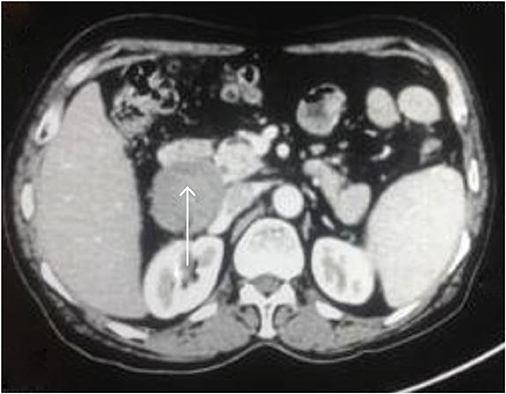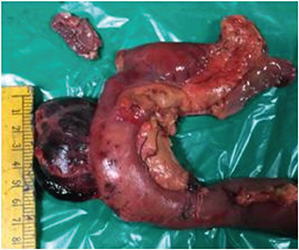J Endocr Surg.
2018 Sep;18(3):210-213. 10.16956/jes.2018.18.3.210.
Duodenal Neuroendocrine Tumor: a Diagnostic Surprise during Workup for Anemia
- Affiliations
-
- 1Department of General Surgery, Seth G. S. Medical College and K.E.M. Hospital, Mumbai, India. maitreyimsp@gmail.com
- KMID: 2420779
- DOI: http://doi.org/10.16956/jes.2018.18.3.210
Abstract
- Neuroendocrine tumors (NETs) arising from the pancreas and duodenum together represent 18% of all gastroenteropancreatic NETs. Duodenal neuroendocrine tumor (D-NET) comprises 1%-3% of all primary duodenal tumors, of these only 20% are resectable. Surgery remains the only curative option provided a R0 resection can be done. We present a case of D-NET in an elderly male who was being investigated for anemia who was treated with pancreaticoduodenectomy and was discharged without sequele.
Figure
Reference
-
1. Yao JC, Hassan M, Phan A, Dagohoy C, Leary C, Mares JE, et al. One hundred years after “carcinoid”: epidemiology of and prognostic factors for neuroendocrine tumors in 35,825 cases in the United States. J Clin Oncol. 2008; 26:3063–3072.
Article2. Hoffmann KM, Furukawa M, Jensen RT. Duodenal neuroendocrine tumors: Classification, functional syndromes, diagnosis and medical treatment. Best Pract Res Clin Gastroenterol. 2005; 19:675–697.
Article3. Modlin IM, Champaneria MC, Chan AK, Kidd M. A three-decade analysis of 3,911 small intestinal neuroendocrine tumors: the rapid pace of no progress. Am J Gastroenterol. 2007; 102:1464–1473.
Article4. Bilimoria KY, Bentrem DJ, Wayne JD, Ko CY, Bennett CL, Talamonti MS. Small bowel cancer in the United States: changes in epidemiology, treatment, and survival over the last 20 years. Ann Surg. 2009; 249:63–71.5. Eriksson B, Klöppel G, Krenning E, Ahlman H, Plöckinger U, Wiedenmann B, et al. Consensus guidelines for the management of patients with digestive neuroendocrine tumors--well-differentiated jejunal-ileal tumor/carcinoma. Neuroendocrinology. 2008; 87:8–19.
Article6. Schraml C, Schwenzer NF, Sperling O, Aschoff P, Lichy MP, Müller M, et al. Staging of neuroendocrine tumours: comparison of [⁶⁸Ga]DOTATOC multiphase PET/CT and whole-body MRI. Cancer Imaging. 2013; 13:63–72.
Article7. Kim MK. Endoscopic ultrasound in gastroenteropancreatic neuroendocrine tumors. Gut Liver. 2012; 6:405–410.
Article8. Delle Fave G, O'Toole D, Sundin A, Taal B, Ferolla P, Ramage JK, et al. ENETS consensus guidelines update for gastroduodenal neuroendocrine neoplasms. Neuroendocrinology. 2016; 103:119–124.
Article9. Barber TW, Hofman MS, Thomson BN, Hicks RJ. The potential for induction peptide receptor chemoradionuclide therapy to render inoperable pancreatic and duodenal neuroendocrine tumours resectable. Eur J Surg Oncol. 2012; 38:64–71.
Article
- Full Text Links
- Actions
-
Cited
- CITED
-
- Close
- Share
- Similar articles
-
- Endoscopic Treatment of Gastric and Duodenal Neuroendocrine Tumors: Present and Future
- Two Cases of Endoscopic Papillectomy for Neuroendocrine Tumor Arising from Minor Papilla
- Endoscopic Papillectomy for Synchronous Major and Minor Duodenal Papilla Neuroendocrine Tumors
- Complete Remission of Metastatic Duodenal Neuroendocrine Carcinoma Treated with Chemotherapy and Surgical Resection
- Duodenal adenocarcinoma following a neuroendocrine tumor in the duodenum



